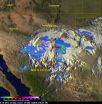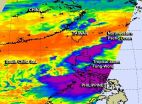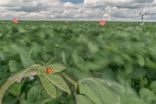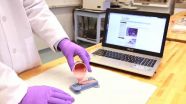(Press-News.org) Cellular therapeutics – using intact cells to treat and cure disease – is a hugely promising new approach in medicine but it is hindered by the inability of doctors and scientists to effectively track the movements, destination and persistence of these cells in patients without resorting to invasive procedures, like tissue sampling.
In a paper published September 17 in the online journal Magnetic Resonance in Medicine, researchers at the University of California, San Diego School of Medicine, University of Pittsburgh and elsewhere describe the first human tests of using a perfluorocarbon (PFC) tracer in combination with non-invasive magnetic resonance imaging (MRI) to track therapeutic immune cells injected into patients with colorectal cancer.
"Initially, we see this technique used for clinical trials that involve tests of new cell therapies," said first author Eric T. Ahrens, PhD, professor in the Department of Radiology at UC San Diego. "Clinical development of cell therapies can be accelerated by providing feedback regarding cell motility, optimal delivery routes, individual therapeutic doses and engraftment success."
Currently, there is no accepted way to image cells in the human body that covers a broad range of cell types and diseases. Earlier techniques have used metal ion-based vascular MRI contrast agents and radioisotopes. The former have proven difficult to differentiate in vivo; the latter raise concerns about radiation toxicity and do not provide the anatomical detail available with MRIs.
"This is the first human PFC cell tracking agent, which is a new way to do MRI cell tracking," said Ahrens. "It's the first example of a clinical MRI agent designed specifically for cell tracking."
Researchers used a PFC tracer agent and an MRI technique that directly detects fluorine atoms in labeled cells. Fluorine atoms naturally occur in extremely low concentrations in the body, making it easier to observe cells labeled with fluorine using MRI. In this case, the modified and labeled dendritic cells – potent stimulators of the immune system – were first prepared from white blood cells extracted from the patient. The cells were then injected into patients with stage 4 metastatic colorectal cancer to stimulate an anti-cancer T-cell immune response.
The published study did not assess the efficacy of the cell therapy, but rather the ability of researchers to detect the labeled cells and monitor what happened to them. Ahrens said the technique worked as expected, with the surprising finding that only half of the delivered cell vaccine remained at the inoculation site after 24 hours.
"The imaging agent technology has been to shown to be able to tag any cell type that is of interest," Ahrens said. "It is a platform imaging technology for a wide range of diseases and applications," which might also speed development of relevant therapies.
"Non-invasive cell tracking may help lower regulatory barriers," Ahrens explained. "For example, new stem cell therapies can be slow to obtain regulatory approvals in part because it is difficult, if not impossible, with current approaches to verify survival and location of transplanted cells. And cell therapy trials generally have a high cost per patient. Tools that allow the investigator to gain a 'richer' data set from individual patients mean it may be possible to reduce patient numbers enrolled in a trial, thus reducing total trial cost."
INFORMATION:
Co-authors include Brooke M. Helfer and Charles F. O'Hanlon, Celsense, Inc. Pittsburgh; and Claudiu Schirda, University of Pittsburgh.
Funding support came, in part, from the National Institutes of Health (grant R01-CA13463) and the California Institute for Regenerative Medicine.
A better way to track emerging cell therapies using MRIs
2014-09-19
ELSE PRESS RELEASES FROM THIS DATE:
NASA catches a weaker Edouard, headed toward Azores
2014-09-19
NASA's Aqua satellite passed over the Atlantic Ocean and captured a picture of Tropical Storm Edouard as it continues to weaken. The National Hurricane Center expects Edouard to affect the western Azores over the next two days.
NASA's Aqua satellite flew over Tropical Storm Edouard on Sept. 18 at 1:45 p.m. EDT and the Moderate Resolution Imaging Spectroradiometer (MODIS) instrument took a visible picture that showed the eye had disappeared and the bulk of clouds pushed east of center.
At 5 a.m. EDT on Sept. 19, Edouard's maximum sustained winds had decreased to near ...
NASA, NOAA satellites show Odile's remnant romp through southern US
2014-09-19
Former Hurricane Odile may be a bad memory for Baja California, but the remnants have moved over New Mexico and Texas where they are expected to bring rainfall there. NASA's TRMM satellite measured Odile's heavy rainfall rates on Sept. 18, and NOAA's GOES-West satellite saw the clouds associated with the former storm continue to linger over the U.S. Southwest on Sept. 19.
The remnants of Hurricane Odile were dropping heavy rain in the area from southern Arizona to western Texas when NASA-JAXA's Tropical Rainfall Measuring Mission or TRMM satellite flew over on September ...
NASA sees Tropical Storm playing polo with western Mexico
2014-09-19
Tropical Storm Polo is riding along the coast of western Mexico like horses in the game of his namesake. NASA's Aqua satellite saw Polo about 300 miles south-southeast of Baja California on its track north.
NASA's Aqua satellite flew over Polo on Sept. 18 at 4:35 p.m. EDT and the Moderate Resolution Imaging Spectroradiometer captured a visible image of the storm that showed that much of the clouds, thunderstorms and showers were west and south of the center of circulation, and away from the coast. That's an indication that easterly wind shear had increased and were pushing ...
NASA eyes Tropical Storm Fung-Wong move through Northwestern Pacific
2014-09-19
Tropical Storm Fung-Wong continued to affect the Philippines while moving north through the Northwestern Pacific Ocean. NASA's Aqua satellite provided infrared data on the storm's clouds that showed some high, strong thunderstorms with the potential for heavy rainfall over the northern and central regions of the country. The storm is now expected to affect three more countries over the next several days.
The AIRS instrument aboard NASA's Aqua satellite uses infrared light to read cloud top temperatures in tropical cyclones. When Aqua passed over Fung-Wong infrared data ...
Dwindling wind may tip predator-prey balance
2014-09-19
MADISON, Wis. — Bent and tossed by the wind, a field of soybean plants presents a challenge for an Asian lady beetle on the hunt for aphids. But what if the air — and the soybeans — were still?
Rising temperatures and shifting precipitation patterns may get the lion's share of our climate change attention, but predators may want to give some thought to wind, according to a University of Wisconsin Madison zoologist's study, which is among the first to demonstrate the way "global stilling" may alter predator-prey relationships.
"There are all sorts of other things that ...
A two generation lens: Current state policies fail to support families with young children
2014-09-19
September 19, 2014 -- Recent two-generation approaches to reducing poverty that help children and their parents are receiving increasing attention from researchers, advocates, and foundations. By combining education and training for parents to enable them to move to jobs that offer a path out of poverty with high-quality early care and education for children, these programs aim to improve the life opportunities of both. However, according to a new report from the National Center for Children in Poverty (NCCP), State Policies through a Two-Generation Lens, while research ...
Soft robotics 'toolkit' features everything a robot-maker needs
2014-09-19
A new resource unveiled today by researchers from several Harvard University labs in collaboration with Trinity College Dublin provides both experienced and aspiring researchers with the intellectual raw materials needed to design, build, and operate robots made from soft, flexible materials.
With the advent of low-cost 3D printing, laser cutters, and other advances in manufacturing technology, soft robotics is emerging as an increasingly important field. Using principles drawn from conventional rigid robot design, but working with pliable materials, engineers are pioneering ...
Fingertip sensor gives robot unprecedented dexterity
2014-09-19
CAMBRIDGE, Mass-- Researchers at MIT and Northeastern University have equipped a robot with a novel tactile sensor that lets it grasp a USB cable draped freely over a hook and insert it into a USB port.
The sensor is an adaptation of a technology called GelSight, which was developed by the lab of Edward Adelson, the John and Dorothy Wilson Professor of Vision Science at MIT, and first described in 2009. The new sensor isn't as sensitive as the original GelSight sensor, which could resolve details on the micrometer scale. But it's smaller — small enough to fit on a robot's ...
Mayo researchers reveal pathway that contributes to Alzheimer's disease
2014-09-19
JACKSONVILLE, Fla. — Researchers at Jacksonville's campus of Mayo Clinic have discovered a defect in a key cell-signaling pathway they say contributes to both overproduction of toxic protein in the brains of Alzheimer's disease patients as well as loss of communication between neurons — both significant contributors to this type of dementia.
Their study, in the online issue of Neuron, offers the potential that targeting this specific defect with drugs "may rejuvenate or rescue this pathway," says the study's lead investigator, Guojun Bu, Ph.D., a neuroscientist at Mayo ...
A refined approach to proteins at low resolution
2014-09-19
Membrane proteins and large protein complexes are notoriously difficult to study with X-ray crystallography, not least because they are often very difficult, if not impossible, to crystallize, but also because their very nature means they are highly flexible. The result is that when a structure can be obtained it is often of low resolution, ambiguous and reveals a mosaic-like spread of protein domains that sometimes create more puzzles than they solve. [Schröder, Levitt & Brunger. (2014), Acta Cryst. D70, 2241-2255; doi: 10.1107/S1399004714016496 ]
Now, Gunnar Schröder ...






